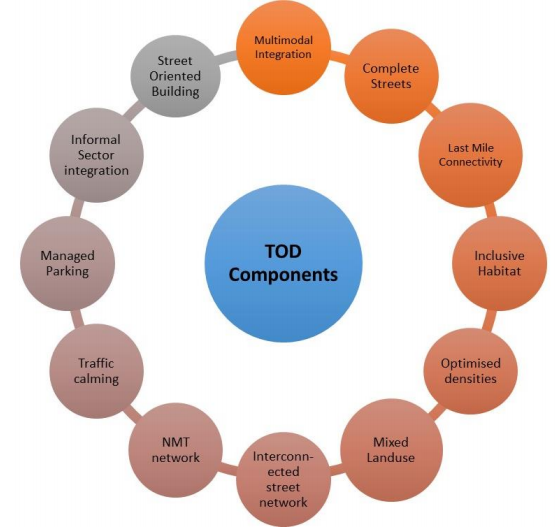Indian Economy
Transit Oriented Development
- 27 Jan 2021
- 5 min read
Why in News
The redevelopment of New Delhi Railway Station (NDLS) has become the first project to be undertaken on the Transit-Oriented Development (TOD) concept in the NCR.
Key Points
- Approving Authority: The project has been approved by the Rail Land Development Authority (RLDA) which is a statutory body under the Ministry of Railways responsible for the development of vacant railway land.
- Currently, the Indian Railways has approximately 43,000 hectares of vacant land across the country.
- The Government, in recent times, has been promoting ‘transit-oriented development’ where public transport is the backbone of cities.
- About:

- Transit-Oriented Development (TOD) integrates land use and transport planning and aims to develop planned sustainable urban growth centers, having walkable and livable communes with high density mixed land-use.
- Plan of TOD:
- A TOD typically includes a central transit stop (such as a train station, or light rail or bus stop) surrounded by a high-density mixed-use area, with lower-density areas spreading out from this center.
- A TOD is also typically designed to be more walkable than other built-up areas, through using smaller block sizes and reducing the land area dedicated to automobiles.
- Need of TOD:
- Factors such as rapidly growing population, Urbanization, migration to cities, and traffic congestion etc.
- Benefits:
- Higher quality of life with better places to live, work, and play, greater mobility with ease of moving around, reduced traffic congestion, car accidents and injuries, reduced household spending on transportation, resulting in more affordable housing etc.
- TOD & Policy Initiatives in India: It is based on three pillars:
- Enable Transformation (From Private to Public Transportation):
- To assist in transformation of cities from private vehicle dependent city to public transport oriented development
- Accessible Public Transport (Promote Green Mobility):
- To promote the usage of public transport by making it accessible, encourage green mobility by encouraging people to walk and cycle and at the same time curb pollution and other negative impacts of motorization.
- Compact Walkable Communities:
- To create livable and affordable communities, which are compact and walkable.
- Enable Transformation (From Private to Public Transportation):
- Objectives of TOD Policy:
- Public Transport:
- To promote the use of public transport and reduction in private owned vehicles by developing high density zones in the influence area, which would increase the share of transit and walk trips and also result in reduction in pollution and congestion in the influence area.
- Reduction in Travel:
- To provide all the basic needs of work/ job, shopping, public amenities, entertainment in the influence zone with mixed land-use development which would reduce the need for travel.
- Road Network:
- To establish a dense road network within the development area for safe and easy movement.
- Inclusivity:
- To develop inclusive habitat in the influence area so that the people dependent on public transport can live in the livable communities within the walkable distance of transit stations.
- To integrate the Economically Weaker Sections (EWS) and affordable housing in the influence zone by allocating a prescribed proportion of built-up area for them in the total housing supply.
- Safety to Vulnerable Section:
- To ensure development of a safe society with special attention to safety of women, children, senior citizens and differently abled by making necessary amendments to the building bye laws.
- Planned Urbanization:
- To prevent urban sprawl by accommodating the growing population in a compact area with access to the transit corridor, which would also consolidate investments and bring down the infrastructure cost for development.
- Climate Friendly:
- To reduce carbon footprints by shifting towards environmentally friendly travel options for the line haul as well as for access and egress trips.
- Public Transport:




